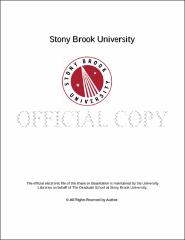| dc.identifier.uri | http://hdl.handle.net/11401/76997 | |
| dc.description.sponsorship | This work is sponsored by the Stony Brook University Graduate School in compliance with the requirements for completion of degree. | en_US |
| dc.format | Monograph | |
| dc.format.medium | Electronic Resource | en_US |
| dc.language.iso | en_US | |
| dc.publisher | The Graduate School, Stony Brook University: Stony Brook, NY. | |
| dc.type | Dissertation | |
| dcterms.abstract | Human skin defends against foreign pathogens with the physical barrier posed by its architecture as well as the large population of resident antigen presenting cells (APCs) that participate in launching both humoral and cellular immune responses. The equipment, storage, and personnel demands posed by intramuscular injection, the gold standard of immunization, hinder rapid distribution of vaccines to large populations under the time constraints of a spreading pandemic. Lower doses of immunogens, successfully delivered into the APC-rich layers of the skin, have been shown to elicit an immune response comparable to that achieved with intramuscular injection. The work disclosed in this dissertation addresses the drawbacks of the current vaccine paradigm through development of a novel skin patch consisting of biologically active antigen macromolecules reversibly encapsulated within a nanofibrous matrix composed of polyvinyl pyrrolidone (PVP). The large surface area to volume ratio offered by the electrospun matrix enhances the attachment of the electrospun patch to the apical skin layer, where its hygroscopic composition exploits transepidermal water transport to dissolve the solid-state patch to then temporarily swell the " brick and mortar anatomy" of the stratum corneum barrier and successfully deliver the released immunogens without resorting to abrasion and puncture of the skin. The self-administrable skin patch developed in this work has been shown to successfully encapsulate biologically active macromolecules such as immunogens for avian influenza, anthrax and whooping cough within the nanofibrous coating. The long-term storage capacity for the proteins has been significantly enhanced by encapsulation within the solid-state matrix, while their biological function and antibody recognition motifs were preserved. The patch's efficacy in delivering antigen payloads into the immunocompetent layers of the human skin has been demonstrated in vitro using commercially available tissue engineered human skin models. Lastly, in vivo application of the patch to the skin of Sprague-Dawley rats elicited a specific immune response to the delivered antigen comparable to that elicited by the intramuscular injection. | |
| dcterms.available | 2017-09-20T16:51:37Z | |
| dcterms.contributor | Simon, Sanford R | en_US |
| dcterms.contributor | Clark, Richard | en_US |
| dcterms.contributor | Hadjiargyrou, Michael | en_US |
| dcterms.contributor | Golubovic-Liakopoulos, Nena. | en_US |
| dcterms.creator | Sawicka, Katarzyna M. | |
| dcterms.dateAccepted | 2017-09-20T16:51:37Z | |
| dcterms.dateSubmitted | 2017-09-20T16:51:37Z | |
| dcterms.description | Department of Biomedical Engineering. | en_US |
| dcterms.extent | 155 pg. | en_US |
| dcterms.format | Monograph | |
| dcterms.format | Application/PDF | en_US |
| dcterms.identifier | http://hdl.handle.net/11401/76997 | |
| dcterms.issued | 2015-08-01 | |
| dcterms.language | en_US | |
| dcterms.provenance | Made available in DSpace on 2017-09-20T16:51:37Z (GMT). No. of bitstreams: 1
Sawicka_grad.sunysb_0771E_11855.pdf: 13935719 bytes, checksum: 3003f85f60e9ab68097e29dba771bce1 (MD5)
Previous issue date: 2014 | en |
| dcterms.publisher | The Graduate School, Stony Brook University: Stony Brook, NY. | |
| dcterms.subject | Adaptive Immunity, Dermal Immunization, Electrospinning, Nanofibrous Matrix, Skin Patch, Vaccine Platform | |
| dcterms.subject | Biomedical engineering | |
| dcterms.title | Development of a Novel Immunization Platform | |
| dcterms.type | Dissertation | |

